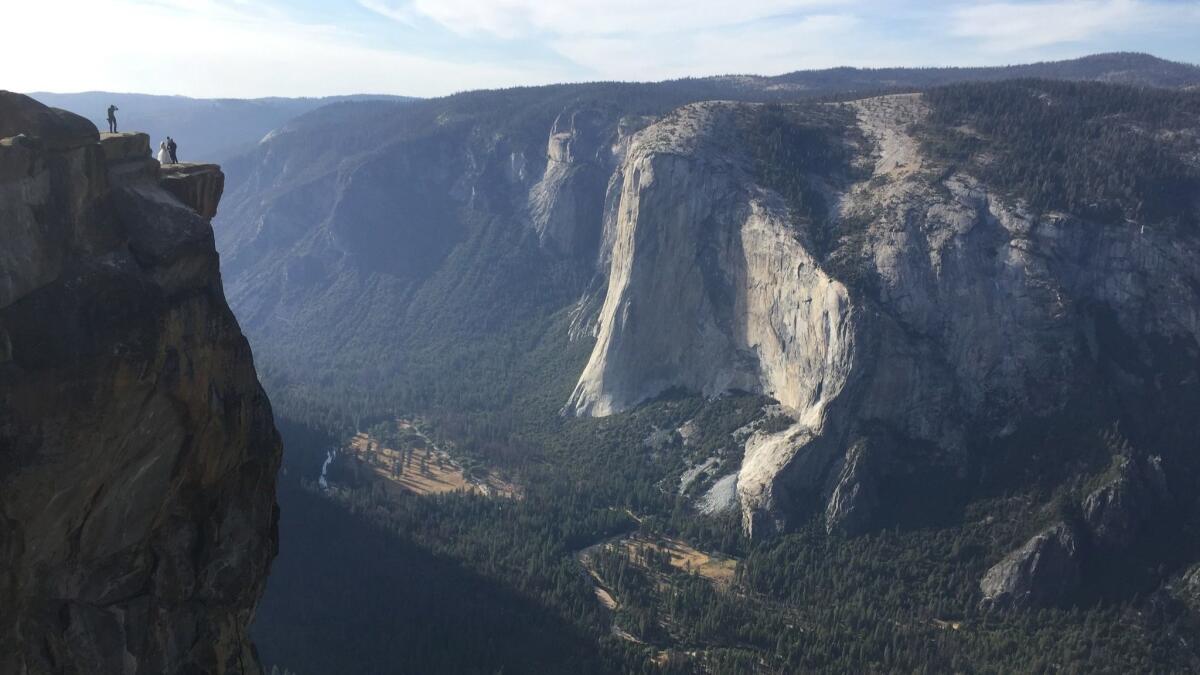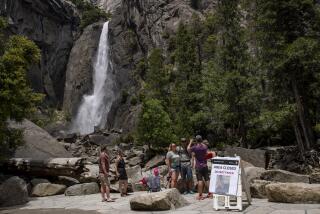Yosemite deaths highlight the danger behind those glorious Instagram posts

- Share via
It was a dramatic engagement photo that quickly went viral.
With the sun setting over Yosemite National Park, a man got to his knees and proposed to his girlfriend at Taft Point, a rock outcropping perched precariously over the valley.
But just days after that image made its way around social media, Taft Point became the focus of a different kind of notoriety.
Another man and woman hiked to the top but then somehow plunged to their deaths. Their bodies were discovered Thursday about 800 feet below the popular hiking destination.
The National Park Service is investigating how the pair fell. But the incident has reignited concern about the risk people take in parks such as Yosemite, where the picturesque vistas are perfect for Instagram or Facebook but can hide the dangers.
On Instagram, posts from visitors climbing to the top of Taft Point show hikers leaping in the air and sitting with their legs dangling off the side of the cliff. There are couples embracing against a sunset backdrop and even exchanging vows in suits and flowing ivory gowns.
Earlier this year, a teenager visiting Yosemite from Jerusalem lost his balance and plunged to his death while reportedly trying to take a selfie at Nevada Fall, a nearly 600-foot-high waterfall on the Merced River.
Divided attention and unfamiliarity with the topography have long played a role in fatal falls at Yosemite and other wilderness parks. But experts said social media has added another element to the mix, with the overwhelming desire to chronicle the beauty of the environment sometimes making visitors more careless.
“Winning the prize sometimes is psychologically more important than the peril of that prize,” said Michael Ghiglieri, who co-authored “Off the Wall: Death in Yosemite,” a 2007 book that chronicles fatal misadventures in the park.
Yosemite is one of the most photographed places in the world, and the familiarity of those images can lead visitors to a false sense of security.
“A lot of people when they’re in a place like Yosemite where there’s spectacular danger, they can’t just be there, they have to brag about it,” Ghiglieri said. “This idea enters like a Grim Reaper with a camera,” he said.
Ghiglieri and others said danger looms at Taft Point and other areas of the national park where people can walk to the edge of cliffs and waterfalls sans railings to capture the perfect, enviable shot.
One website produced safety tips for taking selfies at Yosemite. It urges against posing for photos on granite outcrops, saying “it would only take a loose rock or bad footing to plummet.”
The “bad selfies” list by MyYosemitePark.com also advises against posing near waterfalls, wildlife and rivers. It also reminds visitors to always hold the cables while climbing Half Dome. “Never attempt a selfie on them or try to go up the cables if it is raining, snowing, hailing or looks like it may storm. Both the cables and the rock get really slippery and treacherous,” the website says.
There are limits to how safe park officials can make these majestic outdoor spaces.
Grand Canyon National Park spokeswoman Kari Cobb said the park won’t install a permanent structure such as a guard rail after a visitor fatality or fall because it would compromise the natural integrity of the landscape.
Instead, officials dispatch more rangers along trails where accidents are most common and post safety messages and warnings on maps and at trail heads, she said.
“Ultimately, visitors are accepting an inherent risk when they come and hike here,” Cobb said.
At Grand Canyon, two or three people fall to their death each year on average. About 6.3 million people visited Grand Canyon’s vast expanse in 2017.
At least 10 people have died in Yosemite this year, six of them from falls and the others for reasons including underlying medical conditions to lack of water. That number appears to be trending in line with recent years in which the park has seen 13 to 20 fatalities annually. Yosemite welcomed about 4.3 million visitors last year.
By Ghiglieri’s count, there have been 1,002 traumatic deaths —with more than 300 attributed to falls — at Yosemite since the 1800s.
In May, a man died on Half Dome after he slipped and fell during a thunderstorm on the last 400 feet of the climb, where hikers grasp cables to scale the summit.
The next month, two veteran rock climbers were killed when they fell from the sheer granite face of El Capitan, which rises 3,000 feet and is a favorite challenge for climbers.
In August, two bodies — one of a hiker and another of a missing National Park Service employee — were discovered in the park. It is not clear how they died.
This experience isn’t exclusive to national park visitors. A hankering among local hikers to rack up “likes” and shares on Instagram and other social media sites has led to a significant increase in rescue missions by first responders in the Angeles National Forest.
The Los Angeles County Sheriff’s Department’s search and rescue teams conducted 681 missions in 2017, the largest number in five years.
Ghiglieri said places such as Yosemite have always posed danger to humans. But the smartphone camera adds a different element.
“The big payoff is at war with the normal level of caution we’re born with,” he said.
Times staff writer Laura Newberry contributed to this report.
Twitter: @Hannahnfry
More to Read
Sign up for Essential California
The most important California stories and recommendations in your inbox every morning.
You may occasionally receive promotional content from the Los Angeles Times.











